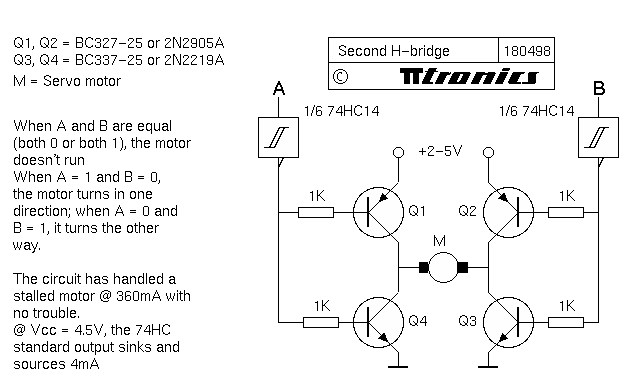An H-bridge is an electronic circuit that enables a voltage to be applied across a load in either direction. They are useful in many applications, especially when you need to make a DC motors to run forwards and backward. H-bridges are available as integrated circuits, or can be built from discrete components. Here are first come discrete circuit ideas.
For low voltage circuits this idea presented at Steve Bolt’s 4-transistor H-bridge looks good basic circuit (classic design):
You should bear the following things in mind with this design: 2N2905 and 2N2219 transistors are no longer being produced. This bridge is “smokeable” — but only if power is supplied to the bridge while the control inputs are allowed to “float”.
Basic Stepping Motor Control Circuits document has on Practical Bipolar Drive Circuits section this H-bridge circuit (Figure 3.14):
The circuit in above consists of two identical halves, each of which may be properly described as a push-pull driver. The X and Y inputs to this circuit can be driven by open collector TTL outputs. The motor winding will be energised if exactly one of the X and Y inputs is high and exactly one of them is low. If both are low, both pull-down transistors will be off. If both are high, both pull-up transistors will be off. As a result, this simple circuit puts the motor in dynamic braking mode in both the 11 and 00 states, and does not offer a coasting mode.
I have always liked this kind of designs when I have needed a simple H-bridge or push-pull driver.
Microcontroller drives piezoelectric buzzer at high voltage article has an interesting looking circuit for MOSFET based H-bridge:
Using four enhancement-mode MOSFETs that connect in an H-bridge configuration, the microcontroller can drive the buzzer at a high alternating voltage. The gate terminals of the N-channel transistors in the lower arms of the bridge can connect directly to the microcontroller’s I/O pins.
When using this circuit be careful not to turn on both PIN1 and PIN2! Doing that would destroy the circuit. If you do the driving with just software (one micro-controller pin per circuit input pin), be careful because with design like this a software bug can cause hardware failure!
I have personally started to move away from H-bridges built from discrete components to H-bridge ICs. You can see one example of such IC in use at my H-Bridge Motor Driver Module article.



2 Comments
Christoph Tack says:
Hi “epanorama”,
could you fix the link to the EDN article halfway this page? It should probably be : https://www.edn.com/microcontroller-drives-piezoelectric-buzzer-at-high-voltage/
Tomi Engdahl says:
Thank you for your feedback.
I just fixed that link.